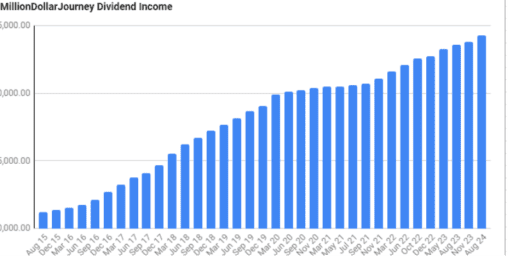Stock Market Beliefs – Part 1
Ed Rempel, a CFP and CMA, has been a regular guest poster on Million Dollar Journey. This time he has written about typical stock market beliefs that are proven false. This is part 1 of 2.
Every once in a while, I come across a truly fascinating book. I love reading financial and investment books. I’ve read most of the major books in the stores and try to read at least one on each theme. But it is rare to come across such an insightful book.
I’m referring to Ken Fisher’s book “The Only 3 Questions That Count”. Ken Fisher is one of those few fund managers that has beaten the index over a long period of time. He is the son of Philip Fisher, who wrote the classic “Common Stocks and Uncommon Profits” in 1958, is a regular columnist for Forbes and is considered the most accurate forecaster by Forbes.
The most amazing part of the book is all the common beliefs about the market that are actually false. In the book, he goes through the numbers to see if many commonly held beliefs are true, and he clearly shows many that are not – a few of which I believed. The title of this article is the first of his 3 questions.
Here is the list, and just to be clear, all of these are proven to be FALSE:
- High P/E markets are riskier than low P/E markets.
- Cheaper stocks do better than less cheap stocks.
- A weak dollar is bad for stocks.
- Rising interest rates are bad for stocks. Falling rates are good.
- A tax cut causes more debt, which is bad for stocks.
- Higher oil prices are bad for stocks and the U.S. economy.
- Stocks do well when the economy does well.
- Stock markets do better in countries with faster growing economies than slower ones.
- Higher risk markets outperform lower risk markets.
- Stocks of firms that grow faster do better than those that don’t.
- Current account and trade deficits will cause the U.S. dollar to fall.
- America has way too much debt.
- The low “personal savings rate” is bad for stocks.
- Small stocks do better than big ones.
- “So goes January, goes the year” (the January effect).
- “Sell in May and buy in September” gives you better returns. Also, Santa Claus rallies, the October effect, Monday effect, Friday effect and Triple Witching.
- A huge terrorist attack (such as destroying a U.S. city) will be very bad for the stock market.
- Stop losses will improve your returns.
- Dollar cost averaging improves your returns.
- Anything you see or hear in the news will move the market.
How many of these do you believe? If you doubt that any of these are false, you should read the book. Ken Fisher quite clearly debunks all of these. While I pride myself in not falling into many common myths, I still believed a few of these.
What is more is that my investment philosophy and portfolio allocation was partly based on some of these. It was quite shocking to me to find things I used for deciding the best portfolio allocation were actually not true!
Even more amazing is the “it’s just the opposite” section. Not only are these items false, but the opposite is true:
- Big government deficits are bad.
- Current account and trade deficits are bad for stocks markets.
- Gold is a good hedge against a declining stock market.
You may doubt that these are false, but the book contains actual stats about each of these that quite clearly disproves them – and sometimes proves the opposite. In part 2, I’ll discuss the rest of the book and show a couple of examples about the above.
But first, I’m really curious about the readers here. Which of the above 23 do you really doubt is actually FALSE?
I've Completed My Million Dollar Journey. Let Me Guide You Through Yours!
Sign up below to get a copy of our free eBook: Can I Retire Yet?











I have say that all of these ‘myths’ are nonsense, these are the worst ones:
#1) I really dislike this “myth” as it could lead investors into calamity, should they believe this nonsense. Look at the following chart “100 years of P/E expansion and contraction”
http://www.ritholtz.com/blog/2010/09/pe-expansion-contraction/
Look at the peaks of P/E ratios – 1929, 1935, 1965 and 2000 … these where long term peaks in the markets – had you invested at these peaks it would have taken years – YEARS to get back to even … High P/E ratios matter.
#12 Really dislike this one as well. If public debts are good for stocks, and good for the economy – then why collect taxes? Nobody likes to pay them – why not just completely debt finance the government? Grown-ups know better. We have to eat broccoli, visit the dentist, and pay taxes.
#17 Really really hate this one. This is the broken windows fallacy at work. What gets missed by these people who claim disasters are good for the economy, are the costs of lost opportunities. For example, a couple who have to make repairs to their home loose out on the opportunity to use the funds to take a vacation – or if they have insurance – the insurance company looses out on the opportunity to keep that money gainfully invested instead of paying out claims. We see the ‘benefits’ of reconstruction – but loose sight of all the transactions that could have happened instead.
Then there are the opposites:
1) why pay taxes if debts are good? we know why – someday the bills comes due.
2) Current account and trade deficits are bad. Eventually capital drains out of the debtor nation and accumulates in the creditor nation. Look at the US – Japan of the 1980s or the US – China of today. Eventually these trade imbalances begin to slow capital formation in the debtor nation.
3) Gold is a hedge against the inflation of currencies, and not stocks or other assets. This is an odd one.
[…] continue on from Part 1 of Stock Market Beliefs, Ed Rempel explains some of Ken Fishers reasonings behind the common stock market […]
[…] In a two-part series, Ed Rempel, a guest writer at Million Dollar Journey, debunks some common stock market adages, which include “High P/E markets are riskier than low P/E markets“, “rising interest rates are bad for stocks. Falling rates are good”, and “America has way too much debt”. […]
Hi Ed!
What a lovely, jucy subject!
Before I hook horns with you about this interesting article, I must admit first that in addition to my humble profession of financial advising I also dabble in other interests, mostly in the humanities. It is there where I find a traditional technic I would wormly recommend in relation to all of this “wisdom.”
I mean to say that a bit of “source criticism” would be well applied here and there.
The issue I have with this line of thinking is, as you say: “What is wrong with stop losses? The fact is that stock prices are not serially correlated. This means that a stock that has just fallen 20%, for example, has the same chance of rising or falling than a stock that has not fallen 20%. For some reason, our illogical minds believe that the stock that just fell 20% is a worse investment than whatever we will buy next.” This may very well be so.
The problem is the somewhat blunt application of the principle.
There is really not much solace in selling after having lost 20%. But if the investor is aware of the nature of his investment and its propensity for fluctuation, then a reasonable “mental treshold” may very well be helpful. If the stock, or fund is habitually fluctuating 2-5 percent, but suddenly produces a 10% drop, you may justifiably ask whether it would be reasonable to sell, preserve the gains attained thus far, and ride out the period of losses, before buying the same back at a reduced price.
As for the “dubious value” of dollar cost averaging, it really is better to invest large sums here and there, then painstakingly contribute periodically. But who amongst us has the luxury to make that choice? I presume, it is a small minority. For the rest of us it is still better to engage in dollar cost averaging then anything else. So the comparison is only favourable in seldom seen circumstances. And by the way the combination of the two is possibly the best.
Sandor
Hi FT,
Since you and several others mentioned stop losses, here is Ken Fisher’s analysis of this myth.
The belief that stop losses protect you and help your returns is based on a strange error in logic. It sounds so good to be able to limit your donwside to 5% or 20%, while still having your full upside. But Ken Fisher calls stop losses “stop gains”.
The brokerage industry promotes them, since they results in more transactions and the strategy is easy to sell. Every time you hit the stop loss, the brokerage firm gets 2 commissions (including when you reinvest.)
Ken Fisher tested different stop losses from 1% to 50% on the S&P500 and found that all of them resulted in lower returns than just buying and holding the S&P!
What is wrong with stop losses? The fact is that stock prices are not serially correlated. This means that a stock that has just fallen 20%, for example, has the same chance of rising or falling than a stock that has not fallen 20%. For some reason, our illogical minds believe that the stock that just fell 20% is a worse investment than whatever we will buy next.
Stock traders will be able to point to a time that the stop losses protected them from a larger loss, but they don’t compare their strategy to just buying and holding. How often does a stop drop by 20% and then shoot up?
Therefore, a stop loss at 20% results in a transaction and transaction costs based on a coin flip. Will the next stock you buy have any better prospects than the one you just sold? What if the replacement stock also falls? You can keep buying 20% losers all the way down to zero.
Here is his example. Amy buys a stcok at $50 and it rises to $100. Sue then buys the same stock after which it falls to $80. Should they both sell or keep holding? Should Amy hold because she is up, but Sue sell because it has hit her stop loss?
The only sure result of a stop loss at any level is more transaction fees. This is why using stop losses – for traders or long term investors – results in lower returns than a buy and hold strategy.
Ed
P.S. In the same chapter, Ken Fisher shows that Dollar Cost Averaging reduces returns (compared to a lump sum investment), and selling covered calls also reduce returns (since a covered call strategy is identical to selling a naked put).
Hi Everyone,
By popular demand, here is why America’s debt it NOT too high.
I have always been somewhat puzzled that the stock market has generally performed better when the Liberals or the Democrats are in power than when the Conservatives or Republicans are in power. As an accountant, I’ve always been dismayed by the waste in government. The more “tax and spend” governments tended to have better stock markets.
Ken Fisher shows that in the 9 years of peak US government deficits, the average stock market gain the following year was 21.8%, while the 9 years with the highest surpluses were followed by an average S&P500 gain of only 0.8%. 7 of the 9 high deficits were followed by gains greater than 10%, compared to only 3 of the 9 years of high surpluses.
I always figured that this must be a delayed reaction to tax cuts and then a delayed reaction to the higher government debt. Ken Fisher calls the government “poli-tic” (poli = many and tic = blood suckers).
I also have found it embarrassing to me to think that my generation – the Baby Boomers – will be known in history as the most irresponsible generation – the one that ran up nearly all our government debt to finance our comfortable lifestyles and that we will leave it to our kids that we have spoiled to pay for our retirement and all the debt we have run up.
This is why I found Ken Fisher’s conclusion so shocking! There is an optimumm debt level. For a company, if they can earn a 15% return by investing in their business and can borrow at 6%, they should of course borrow more – right? If a company can make its shareholders an 8% return by buying back shares, it should issue bonds at 6% to buy back shares – right?
This leads to the surprising question – what is the optimum level of debt for a government? The optimal debt level is where the marginal cost of borrowing no longer is lower than the marginal return on assets. This is basic economics.
Ken Fisher shows the total of all personal, corporate and government debt as $50 trillion vs. $111 trillion in assets. The net is equity of $61 trillion. This is a debt:equity ratio of 85%. Total GDP is $13 trillion, so the return on assets is about 12%. Since the average after tax cost of borrowing is about 4%, this is far less than the return on assets!
How can this be? Economics shows that the average dollar is spent 6 times per year. So, when the government wastes money on some program to generate votes, those same dollars are spent 5 more times – probably all smart spending. For example, the government wastes money paying for advertising, but then the advertising firm hires and pays employees who buy groceries, and then the grocery store pays its employees who spend the money at restaurents, etc.
So the money is wasted once and then spent well 5 times. All 6 spendings are taxable and all of this activity is good for the stock market.
(Incidentally, this optimal debt level applies to individuals as well.)
Let’s be clear – I’m still opposed to more government debt, since our kids will have to pay the interest at the same time they are paying for our higher health care and pensions. We Baby Boomers will vote for more and more money for health care for all of the next 50 years and expect our kids to pay the higher and higher income tax.
However, Ken Fisher’s point explains my earlier question – more government spending is clearly linked to a stronger stock market. This is because both Canada and the US are well below their optimal debt levels – our return on assets is much higher than our cost of borrowing.
Ed
Without knowing his rationales, it’s hard to judge. But if I must, I’d say many items on the list are still true, IF everything else being equal!
For examples:
* High P/E is riskier than low P/E if all other parameters are constant.
* Cheaper stocks do better than less cheap stocks most of the time if both they all have identical fundamentals.
I confess I would have believed almost half of the above to be true (1,7,8,9,10,12,14,17,18).
But then again my DIY investment plan certainly doesn’t count on any of them to be.
Sounds like a good book choice for my next beach vacation!
America has way too much debt.
Seriously, if they don’t have too much debt, then where is their limit?
I think I’m gonna buy the book just to know about that!
FB.
Number 12!
DAvid